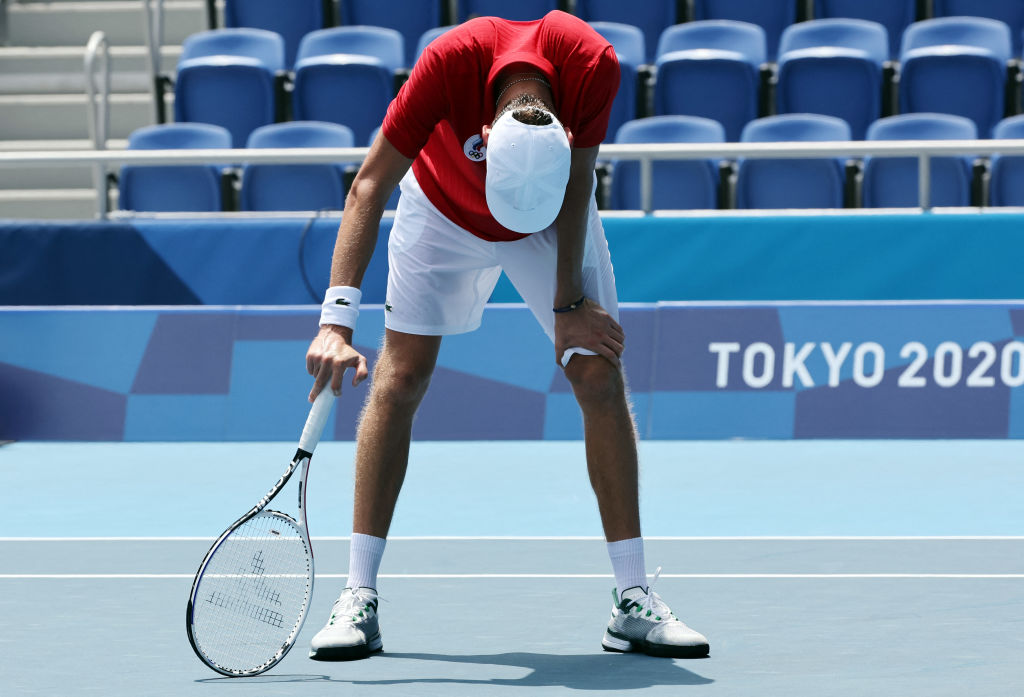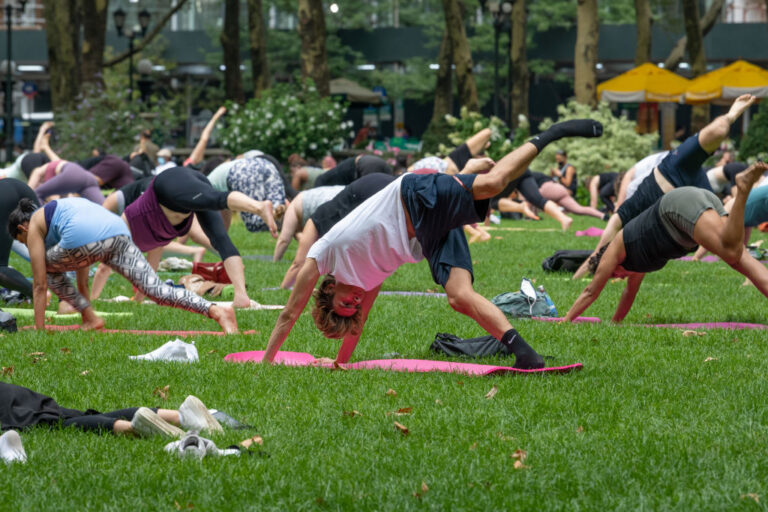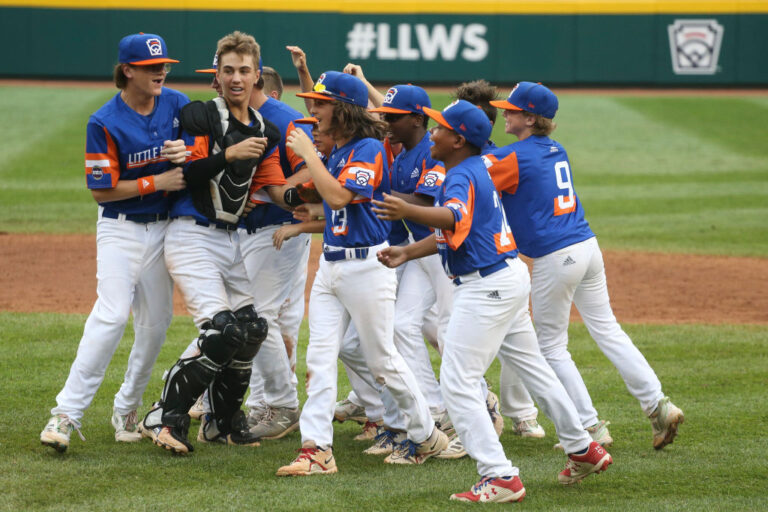Extreme Heat and Air Pollution Create an Uneven and Risky Playing Field
Why this matters
Increasing temperatures and unequal pollution exposures increase disparities and affect participation in youth sport, and thus who might succeed to the elite level.
Dazed and dehydrated, Jim Peters collapsed from heat stroke 200 yards short of the 1954 Commonwealth marathon finish. He was carried off the course and rushed to a hospital, and he subsequently retired from the sport. In the inaugural women’s Olympic Marathon in 1984 in Los Angeles, Gabriela Andersen-Schiess had an unforgettable stadium finish: barely able to walk, she collapsed at the finish line of heatstroke. More recently, Callum Hawkins of Great Britain collapsed from heat exhaustion less than two miles from the marathon finish at the 2018 Commonwealth Games but was not attended to by paramedics for several minutes.
Pushing through extremes is considered heroic. But it also raises a question: Should athletes who are working for optimal performance and trying to make a living be forced to endure extreme conditions that may cause long-term health damage or even death? As climate change continues to manifest across the world with record temperatures and extreme weather, these examples highlight the importance of respecting the heat, what heat can do to our bodies, and what failing to prepare for a hotter future could lead to.
Air pollution, which can be exacerbated by extreme heat, also can affect sports. In urban areas, sporting events like the Olympics are often met with frequent scenes of thick smog, such as in Los Angeles in 1984 and Beijing in 2008. The same can also be true in lower-income communities, many of which are situated in highly industrialized areas near roads or production facilities.
While elite-level events highlight acute environmental impacts on performance, the long-term consequences of extreme heat and air pollution have a disproportionate impact on those less able to cope with such exposures. Healthy and safe outdoor spaces are crucial in lifelong athlete development. Sport shines a global spotlight on these uneven burdens in outdoor sporting activities at every level, where environmental injustices and racism widen the gap in access to clean air and manageable temperatures.
As we strive for equity in historically disadvantaged populations, we must face a hard truth: Many youth athletes exercise in dirty air and dangerously hot environments because of where they live and go to school, thus inhibiting or even preventing safe participation and future athletic success. Those who reach elite levels are often forced to put themselves at risk in competition and struggle through dangerous heat. Understanding how heat and pollution affect the body – and why – is essential to support more equitable and safe participation moving forward.
Extreme Heat and the Body
Viewers of the Tokyo Olympic and Paralympic Games in 2021 heard frequent commentary on the impacts of the extreme temperatures and humidity on athlete performance. Temperatures averaged 90 degrees Fahrenheit during the Games, and humidity was oppressive. In some outdoor events, the effects of heat may have been the difference between a podium finish, not making a final, or simply completing an event. At least 30 athletes reportedly suffered heat-related illness. In men’s tennis, world No. 2 Daniil Medvedev said he “was ready to just fall down on the court” after competing and told the umpire he “might die” if he kept playing.
When exercising in “hot” conditions, the brain tells the body to stop generating so much heat; that translates into less force from muscles, resulting in lower performance output. And when athletes continue to push, the brain can essentially overheat, causing the central nervous system to become chaotic. We feel dizzy, out of control, confused, agitated, and nauseated, and we can lose certain bodily functions – all telltale signs of exertional heat exhaustion and stroke.
William Adams, the associate director of sports medicine research for the U.S. Olympic & Paralympic Committee, writes in an email that the risk of these conditions is lower for recreational athletes, largely because they can choose to not compete in hot conditions. By contrast, elite athletes often do not get to choose: Their livelihoods depend on playing. “The mere existence of sport, and competing at maximal intensities to achieve success (i.e., winning a gold medal), prohibits us from being able to prevent all heat-related illnesses from occurring,” Adams says. “Rather, implementation of effective strategies to prevent death/catastrophic injury from heat-related illness should be the focus.”
The Tokyo 2020 Olympics were held at the hottest and most humid time of the year. Media on heat extremes often overshadowed COVID-19 concerns, with tennis players withdrawing from play in the midday heat due to heatstroke and leaving the court by wheelchair. The Los Angeles Olympics in 2028 are scheduled for late summer (July 21 to August 6), during the area’s hottest time of year and the early and very active part of the wildfire season, thus presenting a high likelihood of exposing athletes and fans to heat and to harmful airborne particulates. Indeed, smoke from wildfires cannot be managed in the same way as extreme heat or traffic/coal fire-related air pollution (as in Beijing). There is also no way for the body to acclimate or become accustomed to air pollution through repetitive exposures the way it can with extreme heat.
Why are sports events held at particularly dangerous times of the year? According to Yuri Hosokawa, a professor at Waseda University and a member of the International Olympic Committee’s Adverse Weather Impact Expert Working Group for the Tokyo 2020 Olympic Games, “organizations and communities tend to have a fixed mindset that certain sports/activities must take place in a certain time of the year.” There may be signs of progress here, however, as the 2022 FIFA World Cup in Qatar was moved to the fall and away from the hottest part of the calendar.
Countries around the world continue to want to host these events to draw excitement and economic investment into their borders, but more consideration should be paid not just to place but to timing and seasonality. Doug Casa, the CEO of the Korey Stringer Institute and a professor at the University of Connecticut, writes in an email that organizers should “have a multifaceted approach to make sure that the heat, humidity, (and) pollution are factored into the bidding and planning process.” He also says that those bidding to be host cities should also present their plans for dealing with these extremes, specifically competition times and medical training.
Invisible but Deadly
Air pollution has been called an "invisible hazard afflicting thousands of schools" by the Center for Public Integrity, and it worsens as temperatures rise on the most painfully hot and stagnant afternoons. The feeling of cooking in a convection oven while ozone pollution lingers in the air will put a damper on anyone’s workout. Air quality problems persistently plague specific areas within cities – those next to highways, industry, open gravel pits, and low vegetation and at low-lying geographies. As a result, low-income communities often face the greatest burden of heat and air pollution across U.S. cities.
The COVID-19 pandemic has exposed respiratory health inequalities in the U.S. Areas with higher air pollution tend to have populations with poorer respiratory health and consequently have suffered worse outcomes from the coronavirus. Though pollution levels in cities across the U.S. have dropped considerably since the 1980s, persistent exposure to moderate to high levels of pollution, whether indoors or outdoors, remains a primary cause of serious lifelong health conditions that can develop in youth. These problems can include childhood asthma (especially for those playing sports in high-ozone communities), childhood lung damage, short-term respiratory infections (which lead to more school absences), and cardiovascular disease.
Adding to these socioeconomic disparities, a sports participation gap exists in the U.S. between youth from lower-income and middle-income families, largely due to the cost of participation. This gap in participation and performance will only widen as climate change hits those with fewer resources harder. A recent study using KSI’s ATLAS data showed that high schools with less access to athletic training services had more lower-income students. Student athletes in Phoenix, Arizona, deal with summertime heat and ozone and wintertime particulate pollution. A recent Arizona Republic article outlines how high school runners are working to clean up the “nasty air” they train within the central and south Phoenix neighborhoods.
Like other major U.S. cities, a history of redlining in Phoenix let banks deny home loans to minorities, essentially aiding in the separation of races during segregation. Work by Arizona State University’s Knowledge Exchange for Resilience shows the historical legacy of underspending in redlined areas – a lack of trees, disinvestment in infrastructure, a higher percentage of people of color, and “deadly health consequences.” This sort of spatial discrimination may leave children playing sports in these areas with lower chances of “making it big” through college athletic scholarships and eventual participation in elite professional sports.
Monica Aceves, a standout high school runner in Arizona, says that she frequently saw her teammates experiencing asthma attacks and ending up in the hospital from running practice. Those with asthma may also need to practice with two inhalers, or even work extra hours to pay for the high cost of medication. According to the U.S. Centers for Disease Control and Prevention, the average annual cost for asthma medication is over $3,000 per person.
While the financial and health costs of air pollution tend to be chronic, exertional heat illness or death is acute – and it can even victimize fit, young athletes. In fact, it is one of the top three causes of sudden death in U.S. sport.
Sports, Climate, and Leveling the Playing Field
How will the sports world cope with rising temperatures? In the future, air-conditioned stadiums – such as at 2019 IAAF World Track & Field Championships in Doha, Qatar – may become the new normal for sports that are traditionally held outdoors. At those same championships, the road marathons and race walk began at midnight to reduce temperatures and sunlight. However, high humidity levels could not be stifled. Almost half of the female marathon field did not finish due to dangerous conditions, with many wheelchaired off the course and needing emergency care.
New ways of managing extreme heat and pollution will be needed. Strategically training in the heat to acclimate to its effects yields numerous physiological benefits, but athletes must have adequate resources – for monitoring, nutrition, and recovery – to safely do so. At the highest level, you likely will see athletes from developed countries wearing ice vests before an endurance event. Such resources, as well as expert knowledge and individualized research, are often available for high-income countries, but less so in developing regions.
Child and youth sports frequently lack the resources needed for protection. For those already disproportionately affected by heat and toxic air, the option to train indoors is often not possible, especially for the lowest-income schools in the dirtiest areas. This can lead to the cancellation of practices, which then hurts those who do not have these facilities, while those with such resources can continue to get ahead.
The solutions differ for limiting adverse impacts of heat and air pollution across athletic levels and subpopulations. As we face increased and compounding issues from both, how can we limit the success gap caused by unequal environmental burdens to youth athletes? And when athletes do make it to the elite level, how can we protect health and best support performance? Here is where to start:
1. Mitigation: While we can focus on reducing temperatures and pollution levels, we have more control over air pollution levels than heat levels by getting rid of pollutants. On a global scale, heat has increased due to climate change, yet on the urban scale and smaller, waste heat (from cars and air conditioners) and urban design (due to the heat retention effects of concrete and asphalt) cause hotter conditions. We can minimize these hotter areas and pollution through strategically placed green infrastructure (trees, hedges) around sports fields to minimize exposures, especially for schools located near busy roadways.
In addition, artificial turf with crumb rubber infill reaches burning levels— 170-180 degrees Fahrenheit on summer days. I was once told by a coach in Texas that their athletes’ football shoes were melting during practice! We should not use this turf and infill.
2. Personnel and Resources: Improving resources to those most in need will save lives. According to Samantha Scarneo-Miller, an assistant professor in human performance at West Virginia University, “the implementation of evidence-based recognition and management strategies such as use of cold-water immersion to treat an exertional heat stroke can be successful in preventing death.” Adams adds that having trained medical personnel on site with the full suite of resources to diagnose and treat a suspected heat-related illness or stroke is critical to achieving this success rate.
3. Education and Smarter Practices: Across all levels, Adams and Scarneo-Miller each emphasize primary prevention of heat illness through performing heat acclimatization, reducing activity and clothing levels as heat rises, and addressing other known intrinsic risk factors, such as body size, fitness, medications, or supplements.
Understanding how to implement primary prevention techniques requires adequate education. According to Hosokawa, “Exertional heat stroke occurs during high-intensity aerobic workouts that might have been intended as punishment. Since it is the coach who is placing athletes at risk in these situations, coach education is imperative.” Numerous devastating examples of heat death during football practice (Jordan MacNair, Max Gilpin) exhibit abuse of coach power. As such, educating all staff, athletic trainers, and athletes is vital. Teammates can support each other and encourage heat-safe activities while also watching for signs of heat illness in each other. (Download a free infographic from ASUNow here to help identify and treat exertional heat illness in student athletes.)
4. Monitoring Exposure Levels: On-site data dramatically improves our ability to make place-based decisions for primary prevention, and data is increasingly required or supported at the highest levels of sports. In recent years, Australian Open viewers now may notice the closing of the main stadium’s roof and tennis players reaching for icy neck towels. These actions are the result of a new policy with court-by-court heat monitoring based on human physiological models by a team of researchers led by Ollie Jay at the University of Sydney.
Similarly, the Tokyo Olympics monitored the “Wet Bulb Globe Temperature” (WBGT) across its sites. So do many other national and international level events. Yet youth sports still require funding to receive even low-cost WBGT monitors. After the Georgia High School Association implemented a new Heat Policy in 2012 based on WBGT monitoring, recorded heat-related deaths dropped to zero. Likewise, air quality monitoring is becoming more common in urban areas and at sporting events and can be used to cancel practices, change location and timing, and even support mitigation activities. World Athletics is implementing a growing network of Kunak AQ sensors designed with athletes’ health as its primary concern.
5. Timing and Location of Practices or Events: Having policies and backup plans in place for changing practice and game times due to heat and pollution – as most sports organizations already do for rain and lightning – is a proactive way to keep athletes safe. Large events also can be hosted in locations and scheduled during times of the year that pose the lowest risks. The best way to avoid the difficult choice between cancellation and placing participants in harm’s way is to prepare beforehand. According to Hosokawa, “we must continue to do a better job not only identifying the risk or reasons to cancel certain events but also proposing alternative options with data.”
Monthly Issue
The Sustainability of Sport
Sport is a large-scale global pursuit that brings together people and places, often creating deep roots with the environment in which it is played. As a result, sport both contributes to ecological change and is affected by it.
As efforts intensify to address decades of carbon emission, commercial growth, and environmental deterioration, sport can take the lead in championing progress. If current trends continue, however, sport could face some of the more serious consequences of a changing Earth.





